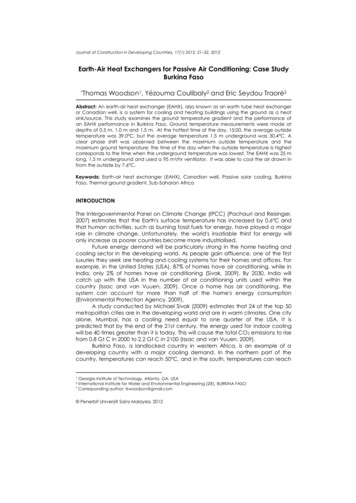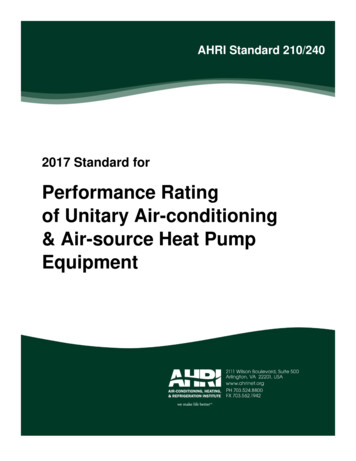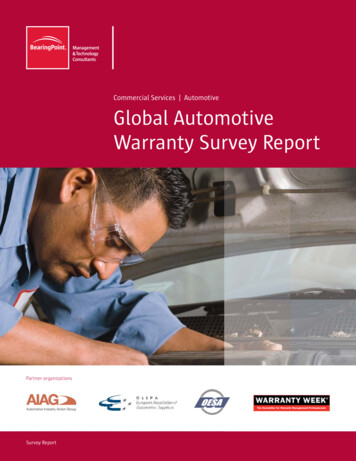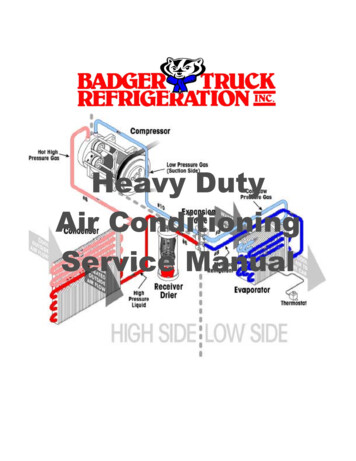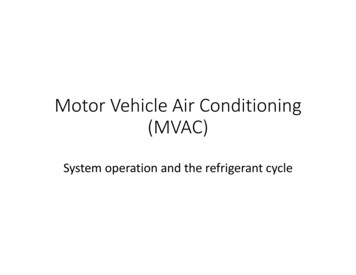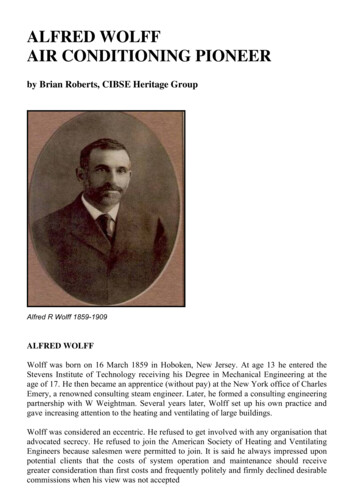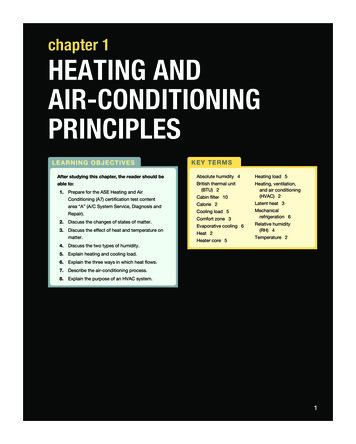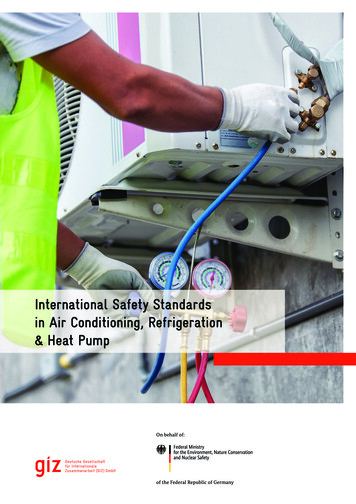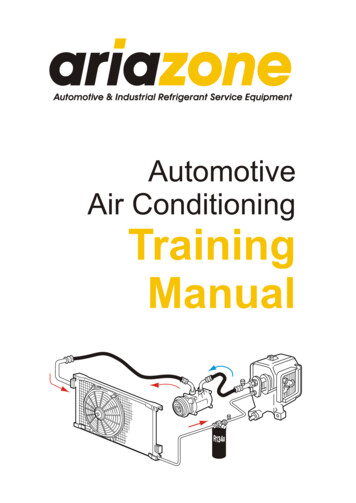
Transcription
AutomotiveAir ConditioningTrainingManual
(I) TheoryThe four major function.3Understanding heat.4Change of state.7Pressure & temperature relationship.8The Ozone Layer.9R134a properties. 10Principles of air conditioning. 12(II) System typesExpansion block valve system.13Parallel flow condenser system. 14Orifice tube system. 15Expansion valve dual system.16(III) ComponentsCompressors.17Clutches.22Lubrication. 23Condensers. .24Foam seals. 25Condenser electric fans. 25Evaporators.26Thermal expansion valve.27Super heat. 29Orifice tube. 30Filter drier receiver. 31Accumulators.32“O” rings.33Hoses.34Charging ports. 35Wiring A/C systems.36Blower speed control. 37Compressor cycling control.38Protective sensors. 42Temperature control.48Mode control. 49Electronic temperature control (ECC). 51(IV) RetrofittingIntroduction. 53Procedures.54Automotive Air Conditioning Training Manual1
(V) EquipmentRecovery&Recycling equipment.56Evacuation equipment. 57Charging stations.59Combination units.60Refrigerant safety.61Leak detections & detectors.62(VI) ServicingLubrications.65Flushing a contaminated systems.66Preparations.67Testing conditions. 68A/C performance check. 69Faulty performance of A/C systems.72A/C system to noisy. 74A/C system emits unpleasant odours . 75The condenser does not dissipate enough heat.76Incorrect refrigerant amount.77Compressor displacement regulation valve defective.78Expansion valve defective. 79Electric compressor clutch slips or does not engage.80Ice on the evaporator core. 81Compressor damaged. 82Hot air infiltrated in the passenger compartment . 83Blockage in the A/C system circuit .84Automotive Air Conditioning Training Manual2
TheoryThe four major functionsTo be effective, the automotive air conditioner must control four (4) conditions within thevehicle interior:It must cool the airIt must circulate the airIt must purify the airIt must dehumidify the airThese functions are essential if passenger comfort is to be maintained when the ambienttemperature and humidity are high.By performing these functions, the air conditioner maintains the body comfort of thepassengers.Automotive Air Conditioning Training Manual3
TheoryUnderstanding heatWhat is heat?To understand just how an air conditioning system works, we must first understand thenature of heat.For a simple definition we may say that heat is energy. The meshing of gears, the turning ofwheels cause friction which results in heat. Combustion (fire) gives off heat. The burning ofsun radiates heat to the earth's surface.Heat in the correct amount will provide life and comfort. Heat in either extreme - extreme tomuch or to little - will be uncomfortable.The control of temperature means the control of comfort.Air conditioning is a method of controlling heat.When is heat hot?When is heat cold?All substances contain heat. Something "feels" hot when it is warmer than our bodytemperature. When something contains less heat than our bodies, we say it feels cold!Cold is merely the removal of some heat.Science tells us that a measurement called "Absolute Zero" is the point at which all heat isremoved from an object (approximately -273 C). Any substance above this absolute zerotemperature retains some heat.The burning of the sun radiates heat to the earth.Automotive Air Conditioning Training Manual4
TheoryUnderstanding HeatAll substances contain heatThe average person requires a comfortzone of approximately 21 C to 26 C, witha relative humidity of 45 to 50%. In thistemperature and humidity range, we feelmost comfortable. All objects within thissame range are comfortable to touch.As the temperature of anything goesabove or below this range, we think of itas HOT or COLD.Heat measurementA temperature reading gives us the heatintensity of a substance and not theactual quantity of heat.Heat quantity is measured in"KILOCLORIES" (KCAL's). One KCAL isthe amount of heat required to raise thetemperature of one kilogram of water onedegree Celsius (at sea level). Thisquantity measurement is used in airconditioning to describe heat transferduring changes of state.1 00 KCA LWhat causes heat to move?Ambient 25 CHeat always moves from the hotter objects tothe colder one. Whenever there is a transferdifference between two objects, the heatenergy will be transferred from the warmerobject to the cooler one until both objectsstabilize at the same temperature.This is known as the law of heat transfer,and is the basis of air conditioning operation.When a hot cup of coffee is set aside forsome time, it becomes cold. Heat moves outof the hot (90 C) coffee into the cooler (25 C)surrounding air. In time the coffee will reachthe temperature of the surrounding air.Automotive Air Conditioning Training Manual90 C25 C5
TheoryUnderstanding HeatHow does heat get inside a vehicle?When a car is driven or parked in the sun, heat enters the vehicle from many sources.These sources include:- Ambient air- Sunlight- Engine heat- Road heat- Transmission- Exhaust heatAll of these and other miscellaneous heat sources, increase the air temperature within thevehicle. In a high ambient temperature situation, (e.g. on a 37 C day), the interior of avehicle left standing in the sun with windows closed could reach 65 - 70 C!SunloadSunloadSunloadEngine HeatExhaust HeatExhaust HeatRoad HeatAutomotive Air Conditioning Training Manual6
TheoryChanges of stateEvaporationIs the term used when enough heat isadded to a liquid substance to changeit into a vapor (gas). For example,when water is boiled.VapourThis condition occurs within the A/Csystem.LiquidCondensationIs the term used to describe theopposite of the evaporation process. Ifyou take a vapor and remove enoughheat from it, a change of state occurs.The vapor becomes a liquid.GlassLiquidThe change of vapor to a liquid iscalled condensation.VapourThis condition occurs within the A/Csystem.LiquidFreezingIs another change of state. Freezingresults when heat is removed from aliquid substance until it becomes asolid. Remember that anything above-273 C still contains some heat.In an air conditioning system freezingmust be avoided. Otherwisecomponent damage will occur.Automotive Air Conditioning Training ManualLiquid7
TheoryPressure & temperature relationshipTo increase or decrease the boiling point ofa substance, we must alter the pressure onthe substance. Increasing the pressureincreases the boiling point.70 CMt EverestTo decrease the boiling point, decrease thepressure.8848m100 CSea levelA good example is the automotive coolingsystem.110 kPaThe pressure cap keeps the radiator fromboiling over by increasing the pressure onthe coolant.Example:110 kPa radiator cap allows the coolanttemperature to reach 126 C before boiling.This chart opposite shows that the boilingpoint of water can be altered by changingthe pressure upon it.Boiling Point of WaterPressureabove sea temperaturelevelC(kPa)OAs a comparison with the radiator exampleabove.The substance used in the air conditioningsystem, called refrigerant, also boils atdifferent temperatures depending on thepressure that it is under.Automotive Air Conditioning Training ManualOPressureabove sea 88
TheoryThe ozone layerOzone (O 3 ) is formed in upper atmosphere (stratosphere), approximately 10 to 50 km above theearth surface.This layer acts as a shield that protects the earth's surface from harmful ultra violet radiation comingfrom the sun.The chlorine contained in CFC's rise into the ozone layer and destroys the ozone molecule O 3 .Depletion of the ozone layer can be catastrophic to human life causing problems such as:- Skin cancer- Eye cataracts- Reduced immunity to disease- Damage to crops- Reduced aquatic lifeBackground1974 - It was first recognized that the use of chlorofluorocarbons (CFC's) was potentially having adetrimental effect on the ozone layer.1987 - The Montreal protocol was adopted. This protocol called for restrictions on the manufactureand usage of CFC's to 1986 levels. From 1987 manufacturers could only produce the samequantities as produced in 1986.1990 - A second Montreal protocol meeting was held and recommended a total phaseout of ozonedepleting refrigerant by the year 2000.2000 - Total phaseout of CFC's.OZONEERYALAutomotive Air Conditioning Training Manual9
TheoryR134a PropertiesSince 1993 the Automotive industry of developed countries has started to use anon-ozone-depleting refrigerant HFC 134a (hydrofluorocarbon), its chemical name beingTetra Fluoroethane. We commonly refer to this refrigerant as R134a.R134a was selected as a replacement refrigerant for R12 (Dichlorodifluoromethane)because R12 containing chlorine has a major effect to ozone layer depletion.R134a and water
Automotive Air Conditioning Training Manual 9. R134a Properties Since 1993 the Automotive industry of developed countries has started to use a non-ozone-depleting refrigerant HFC 134a (hydrofluorocarbon), its chemical name being Tetra Fluoroethane. We commonly refer to this refrigerant as R134a. R134a was selected as a replacement refrigerant for R12 (Dichlorodifluoromethane)
